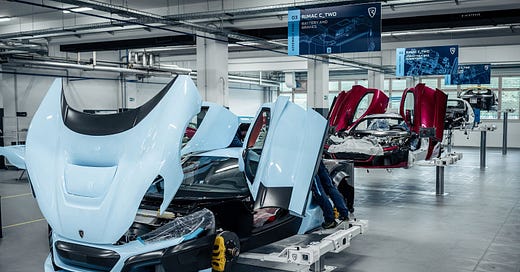
Croatian startup Project 3 Mobility (P3), founded by Mate Rimac, CEO of Rimac Group and a Bugatti-Rimac joint venture, unveiled on June 26 its self-driving robotaxi Verne last week, though without the expected hype.
Setbacks, such as the vehicle failing to move on multiple occasions and respond to commands, marred an event that was supposed to showcase Croatia's advancement in autonomous technology.
The autonomous vehicle’s poor performance has raised questions among domestic journalists about the feasibility of the project and the use of European Union (EU) funds for the autonomous vehicle named after the 19th-century French science fiction writer Jules Verne.
Rimac, known for his high-performance electric hypercars, had shifted his focus to autonomous urban transport through the P3 project. Innovating in those fields is important for the EU because these technologies, including artificial intelligence, sensor fusion and computer vision, will have applications in other fields, such as robotics and healthcare.
"What we are trying to do is deliver a luxury car experience in the space of a compact car," Rimac said at the event. "It's the size of a smaller vehicle but has higher safety and higher comfort than a luxury car.”
P3 Rollout Delays
P3 had planned to have 100 autonomous vehicles operational in Zagreb by the end of 2024. Given the setback at the launch, the company has moved the goalposts, targeting a 2026 launch.
The P3 autonomous vehicle setback, though, is part of a broader trend within autonomous vehicles industry. Their adoption globally has slipped by two to three years on average across all levels relative to a 2021 McKinsey and Co. study.
Level 4 (L4) autonomous vehicles, which can intervene independently if things go wrong or there is a system failure, are now expected to become commercially available on a large scale by 2030 and fully autonomous trucking is expected to reach viability between 2028 and 2031.
To reach L4 and higher levels of autonomy, “significant investment cumulative until first commercial launch is needed,” McKinsey said. More than $4 billion for full-journey autonomous trucks is expected to be needed and investments for Level 3 highway use cases (more than $2 billion) and L4/5 robotaxis (more than $5 billion) are expected to double from what the previous survey estimated.

Mobileye Technology
The vehicle's autonomous driving technology is licensed by Mobileye Global, an Israeli firm specializing in self-driving systems, which was acquired by Intel (NASDAQ: INTC) in 2017.
This partnership is central to Verne's functionality. It also highlights a reliance on external technology rather than homegrown innovation.
The Verne robotaxi is designed as a two-seater autonomous pod, eliminating traditional driving controls like a steering wheel and pedals. It features a 43-inch screen for entertainment and information, a 17-speaker sound system and "five different levels of comfort" in its seats. The design is heavily inspired by futuristic concepts, aiming to create a "living room on wheels."
Croatia PM Attends
Croatian Prime Minister Andrej Plenković, who is considered pro-business and pro-tech, attended the event and expressed his support for the project.
"I’m glad that we supported this project with significant funds,” he said. “It is very good that, in the regulatory part, we will be among the pioneers."
The project's reliance on significant public investment necessitates greater transparency and accountability, critics argued. The public sector had a hefty price tag: a €180 million EU grant.
"When public money is involved, entrepreneurs have a responsibility to the community that financed them," said Marko Rakar, an IT expert and political consultant. "Yesterday's presentation is just a formal fulfillment of requirements to justify EU money. Total science fiction, undisguised."
Private Sector Support
Still, P3 received significant support from private investors, attracting €100 million in Series A raise in February from Tasaru Mobility Investments of the Saudi Public Investment Fund, South Korean automaker Kia, and Rimac Group.
P3's plans expand beyond Zagreb, targeting cities across the UK, Germany, and potentially the Middle East. Per Lider Media, contracts have been signed with 11 cities, with discussions ongoing with over 30 more, yet the company has not disclosed the details.
Like other autonomous vehicle players, P3 must navigate national and regional regulations as they are still being developed and enacted. About 60% of respondents in the January Mckinsey & Co. survey believe that regulation is the biggest bottleneck to autonomous vehicle adoption.

Unresponsive to Commands
A key criticism centers on the project's reliance on Level 5 autonomous driving technology, which experts like the former General Motors R&D Chief Larry Burns believe impossible. Level 5 denotes complete autonomy, with no human intervention required.
The poor performance at the launch parallels other high-profile product mishaps, such as Tesla's Cybertruck that suffered a window break during Musk’s presentation in November 2019.
At the P3 event, the Verne robotaxi failed to respond to Rimac's command to move forward, remaining motionless. He attempted to downplay the issue.
"We tried it a hundred times and it worked,” he said. “Our technicians will solve the problem quickly."



